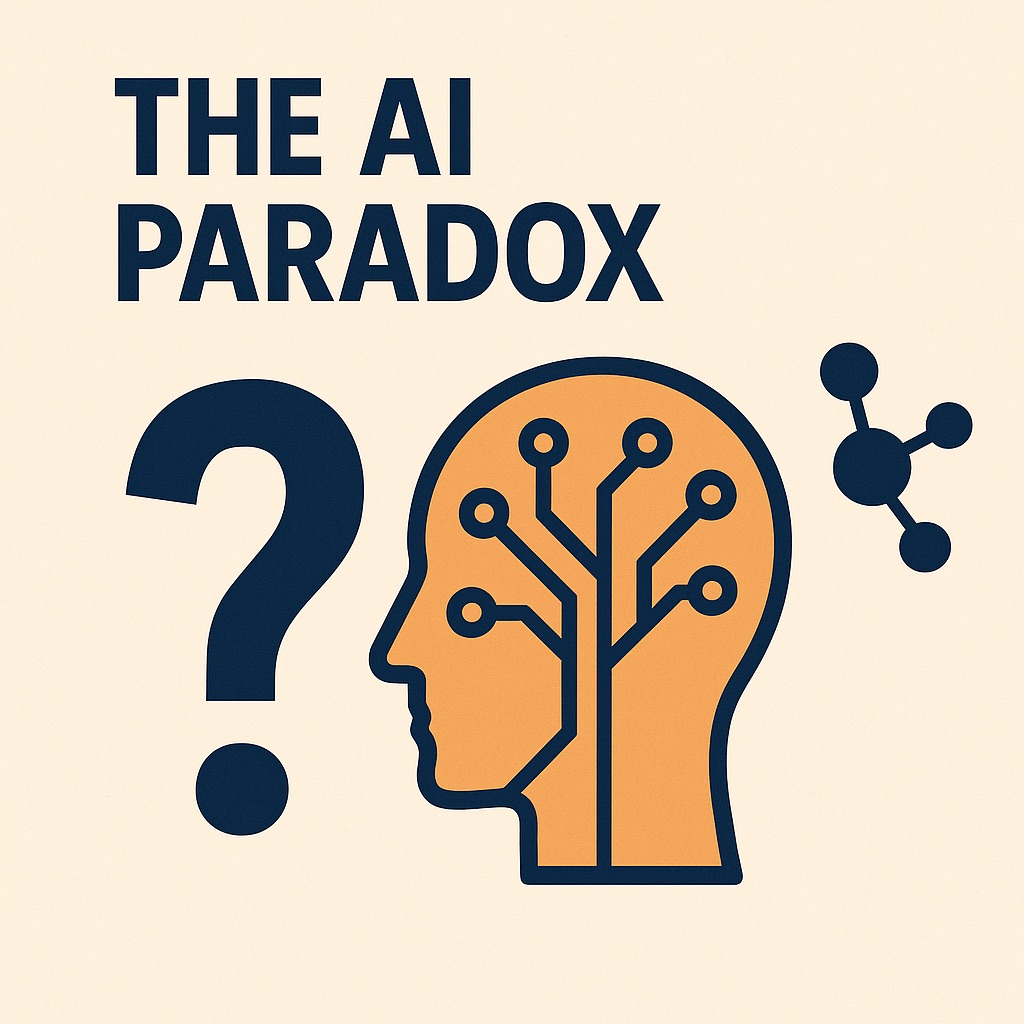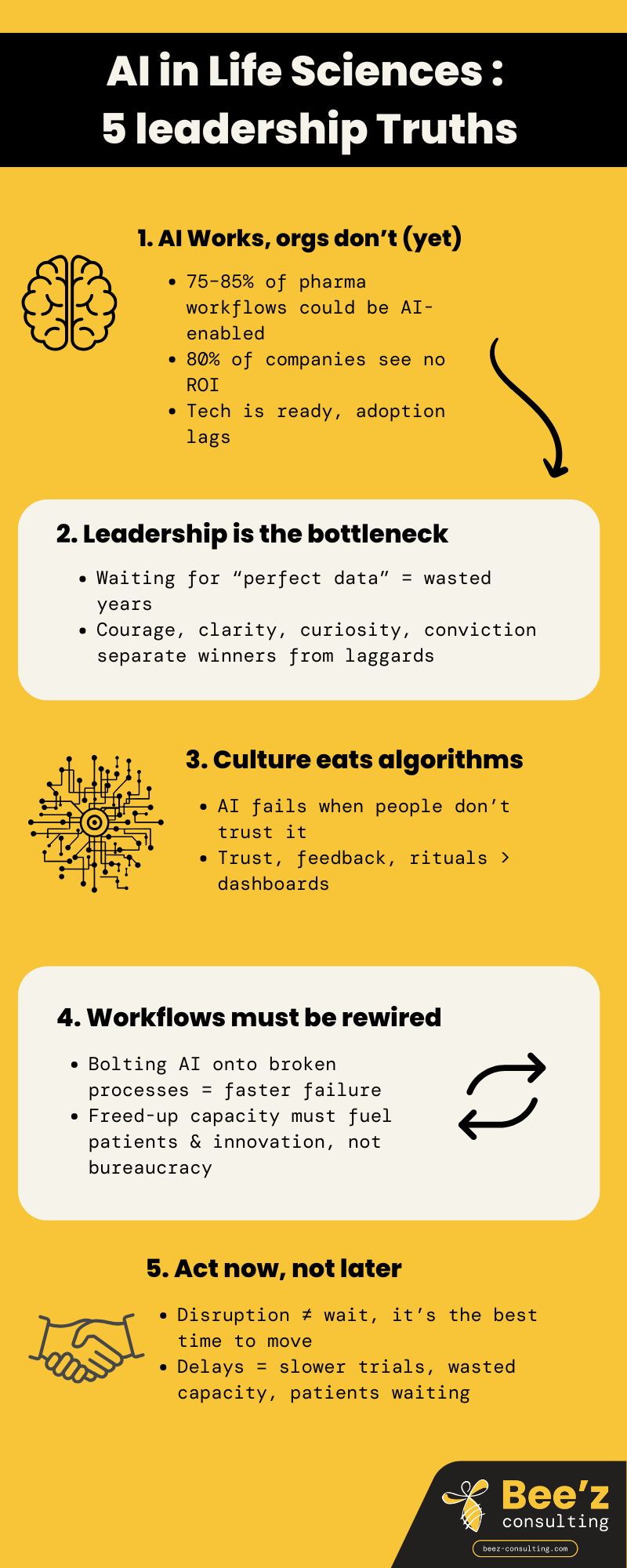
AI is everywhere in life sciences. It can design trial protocols in minutes, flag side effects before they appear, and even draft regulatory documents while you sleep.
And yet — 80% of companies using AI report no impact on their bottom line (McKinsey, 2025).
It’s absurd, isn’t it? We trust algorithms to predict how a molecule behaves in the human body, but we don’t trust them to draft a contract. We let AI scan terabytes of trial data, but we still struggle with the silence in a boardroom when no one dares to decide.
The truth: the barrier isn’t the tech. It’s us. How leaders make choices. How teams adapt. How culture absorbs change.
And here’s the urgency: every month of hesitation is another month of slower trials, wasted capacity, and patients waiting for therapies that could already be in their hands.
McKinsey’s Life Sciences Practice and QuantumBlack analyzed more than 270 workflows and 1,200 tasks across pharma and medtech. Their conclusion?
- 75–85% of pharma workflows can be enhanced or automated by AI agents.
- 70–80% of medtech workflows are also “agentifiable.”
- That translates into freeing up 25–40% of organizational capacity — time scientists, clinicians, and teams could redirect to higher-value work.
On paper, that’s billions in productivity. That’s faster discoveries, more efficient trials, and more time with patients.
The potential is staggering:
- Pharma could see 5–13% incremental growth and a 3.4–5.4 point lift in EBITDA within 3–5 years.
- Medtech could add 3–7% growth and 2.2–4.7 EBITDA points (McKinsey, 2025).
But here’s the paradox: despite this potential, 80% of organizations still fail to capture any bottom-line benefit.
Why? Because most AI projects stay stuck in pilot mode. Innovation labs test shiny new use cases while frontline teams keep working the old way. Leaders wait for perfect data instead of making bold decisions. Risk aversion eats away at momentum.
Meanwhile, the industry’s pressures don’t wait:
- Blockbuster drugs are nearing patent cliffs.
- R&D costs are climbing.
- Supply chains are fragile.
- Clinicians and researchers are burning out.
So yes — AI works. But unless leaders and cultures rewire, the absurd becomes reality: we can simulate molecules in silico but can’t redesign a single meeting agenda.
Let’s be clear: the main reason AI fails in life sciences isn’t data quality or regulation. It’s leadership hesitation.
McKinsey is blunt: without a clear, top-down mandate, AI will stay stuck in pilots. Yet many leadership teams play it safe. They wait for “perfect data.” They create new committees. They hide in more strategy decks.
Meanwhile, trials drag on. Margins shrink. Patients wait.
Here’s the absurdity: companies will spend millions on AI platforms, but hesitate to spend one hour deciding how freed-up capacity should be used. Should it go to innovation? To patient care? To reducing burnout? The silence is costly.
In our work, we’ve seen the difference when leaders step up. The best don’t chase every shiny tool. They focus on four traits that cut through the noise:
- Courage to make bold choices before a crisis forces them.
- Clarity to set a long-term direction instead of trying to be everything to everyone.
- Curiosity to challenge the status quo and test new ways of working.
- Conviction to stay the course when results don’t come overnight.
Take one healthcare group we know. A decade ago, it was anchored in acute-care hospitals. But leaders saw the ground shifting: rising costs, changing reimbursement, new patient expectations. They had a choice: protect the old model or reinvent.
They chose reinvention. They expanded into ambulatory services, invested in digital tools, and reshaped their governance so leaders could balance short-term numbers with long-term bets.
It wasn’t easy. Boards demanded results. Clinicians worried about workload. Transformation took years. But courage and conviction kept them moving.
That’s the real test: not another AI pilot, but whether leadership teams have the courage to choose, the clarity to focus, the curiosity to explore, and the conviction to persist.
Because without those, AI is just another slide in another strategy deck.

AI doesn’t fail because the models are weak. It fails because people don’t use them.
McKinsey found that 95% of life sciences roles could have AI “teammates” — agents helping with data, documents, or workflows. That means almost every scientist, clinician, or manager could be working alongside AI tomorrow.
But here’s the reality: many don’t.
- Site managers still double-check every contract an AI drafts.
- Scientists rerun analyses the algorithm already validated.
- Teams treat AI outputs as “suggestions,” then quietly ignore them.
Absurd, isn’t it? We let AI analyze terabytes of clinical data, but won’t trust it to produce a routine report.
The barrier isn’t the code. It’s confidence. If teams don’t trust the system, if they don’t see it as reliable, they will work around it. And when that happens, adoption dies in silence.
That’s why culture matters more than algorithms. You can buy the best models in the world, but without trust and ownership, they’ll sit unused.
What works instead? Small, repeatable practices that build confidence:
- Leaders who set the tone by saying, “We’re testing this tool in one workflow. Mistakes are part of the process.”
- Teams who run short debriefs after each use: “What worked, what didn’t, what do we try next?”
- Managers who highlight early wins, even small ones, so people see progress.
These micro-practices turn hesitation into confidence. They make AI part of the daily workflow instead of a threatening black box.
Because culture eats algorithms for breakfast. And right now, in too many organizations, culture is still winning.
Here’s a hard truth: bolting AI onto broken workflows only makes the pain worse.
McKinsey calls this out clearly: AI’s potential comes not from sprinkling it into old systems, but from reimagining entire workflows.
Think about it:
- If a scientist spends half their week cutting and pasting data into spreadsheets, adding an AI to “summarize” that mess doesn’t create value.
- If clinicians are buried under compliance paperwork, throwing another digital layer on top just shifts the burden, it doesn’t lift it.
The real breakthrough comes when organizations ask: What work should look like if AI is a teammate from the start?
Concrete examples:
- In R&D, documentation agents can auto-draft regulatory files, freeing researchers to focus on analysis. That’s not saving minutes — it’s reclaiming weeks.
- In operations, supply chain agents can track raw materials and adjust production in real time, reducing shortages and delays.
- In clinical trials, contracting agents can prepare “first time right” site agreements, doubling activation speed while cutting staff hours by 30–50%.
Here’s the absurdity: life sciences companies can design therapies that reprogram cells, but many still route invoices manually for approval. AI won’t fix that inefficiency unless the workflow itself is redesigned.
And here’s the choice: freed-up capacity doesn’t automatically create impact. It can easily be swallowed by bureaucracy if leaders don’t make it a strategic decision. Do we use that capacity to push forward new therapies? To give clinicians back time with patients? Or do we lose it to more meetings and reporting?
The winners will be those who rewire workflows from the ground up, making AI part of the design, not an afterthought.
AI in life sciences is not a “someday” opportunity. It’s here. The question is whether leaders will unlock its value — or let it stall in pilots while competitors race ahead.
Here are five urgent moves leaders can make today:
1. Don’t bolt AI onto broken workflows.
Redesign the work from the ground up. Otherwise, AI just automates inefficiency.
2. Talk openly about trust, not just data.
If teams don’t believe the system adds value, they’ll ignore it. Build confidence with transparency, quick pilots, and honest reviews.
3. Decide now where AI creates value.
Stop waiting for “perfect data.” Choose a handful of high-value workflows, test them, and scale what works.
4. Redirect freed-up capacity with intention.
AI can free 25–40% of people’s time (McKinsey). Leaders must decide: will that go to patient care, faster R&D, or more bureaucracy?
5. Make learning a ritual.
Don’t frame AI adoption as a one-off transformation. Create small, repeatable practices that help people adapt and improve continuously.
These moves sound simple. But they separate the companies that unlock AI’s full promise from those still talking about it at next year’s board meeting.
Because the paradox is clear: the technology works. The only question is whether leadership and culture will keep up.
AI is no longer the question. It works. It can draft trial protocols, analyze terabytes of data, and automate compliance tasks in ways unthinkable a few years ago.
The real question is: will leadership and culture unlock it, or waste it?
It’s almost absurd when you think about it. We let AI simulate molecules, but we won’t trust it to manage a contract. We invest millions in platforms, then hesitate to decide how to use the time they free up.
The stakes are not just financial. Every delay means slower trials, wasted capacity, and patients waiting for therapies that could already change their lives.
This is a choice point for life sciences leaders. Those who act now — with courage, clarity, and conviction — will set the pace for the next decade. Those who hesitate will be left watching.
At Bee’z, we’ve seen the turning point firsthand: when leaders rewire culture, decisions, and workflows to match the speed of technology. That’s when AI adoption stops being a pilot, and starts becoming real impact — for patients, for teams, and for the business.
The future is ready. The algorithms are ready.
The question is: are we?


Growth in healthcare isn’t about getting bigger anymore. It’s about getting better — and Europe’s hospitals are showing how. Discover how the next wave of leaders is changing healthcare.


From blame to accountability : how a culture of responsibility boosts care quality, engagement, and performance in healthcare. Let’s talk about this !


AI is everywhere in life sciences. It can design trial protocols in minutes, flag side effects before they appear, and even draft regulatory documents while you sleep.
